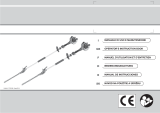
22
GB
17. Do not use the mist blower near to electrical
equipment and electric lines.
18. Do not knock or force the rotor blades; never
work with damaged rotors.
19. Do not use the mist blower with
inflammable and/or corrosive substances.
20. Do not assemble the rotor on other motors or
power transmissions.
21. Do not obstruct or close the rotor air intake.
22. Do not utilize the machine for uses different
from the ones specified in the manual (see
pag. 27).
23. Never leave the machine unattended with the
engine running.
24. Please note that the owner or the user is
responsible for any accidents or damage to
third parties or their property.
SAFETY PROTECTIVE CLOTHING
When working with the mist blower, and
indeed whenever crop-spraying chemicals are
being handled (transport, storage, mixing,
maintenance of equipment, etc.), always wear
and use the appropriate PPDs. The use of
Personal Protective Devices is essential, otherwise
the operator will run the risk of exposure to
hazardous chemicals. Consult your trusted
supplier to choose an adequate equipment.
The clothing must be proper and not an obstacle.
Wear adherent protective clothing. Full-body
overalls are best. Do not wear clothes, scarves,
ties or bracelets that can stuck into twigs. Tie up
and protect long hair (example with foulards,
caps, helmets, etc.).
Safety boots having skid-proof sole and anti-
piercing insert.
Wear protective goggles or face screens!
Wear an approved breathing apparatus when
spraying liquids or powders.
Use protections against noises; for example
noise reduction ear guards or earplugs. The
use of protections for the ear requests much
3. Do not use the mist blower when physically
tired or after having taken alcohol, drugs or
medication.
4. Never wear scarves, bracelets or anything else
which could be taken up by the rotor. Wear
suitable protective gear (PPDs), especially
gloves, overalls, goggles and ear defenders.
5. Never allow bystanders or animals to remain
within your working area when starting or
working with the mist blower.
6. Always work from a firm-footed and safe
position.
7. Keep hands well away from the rotor or
attempt to service the mist blower while the
engine is running.
8. Check the mist blower each day to ensure
that each device, whether for safety or
otherwise, is functional.
9. Never use a damaged, modified, or
improperly repaired or assembled mist
blower. Do not remove, damage or
disactivate any of the safety devices.
10. Only use the mist blower in well-ventilated
places. Do not operate the mist blower
in explosive atmospheres, in closed
environments or near inflammable
substances.
11. Only fit rotors supplied by the manufacturer
to the mist blower power takeoff.
12. When the mist blower is at the end of its
useful life, do not simply dump it; either
return it to the dealer or take it to a waste
collection and recycling centre.
13. Only loan your mist blower to expert users
who are completely familiar with mist blower
operation and correct use. Give other users
the manual with operating instructions,
which they should read before using the mist
blower.
14. Keep this manual on hand and consult it
before each use of the tool.
15. All labels with health hazards must be kept
in good conditions. In case of damage or
deterioration, immediately substitute them
(Fig.19).
16. Never start the machine without rotor. It will
cause serious demages to the engine parts as
well as the withdrawal of the guarantee.

























